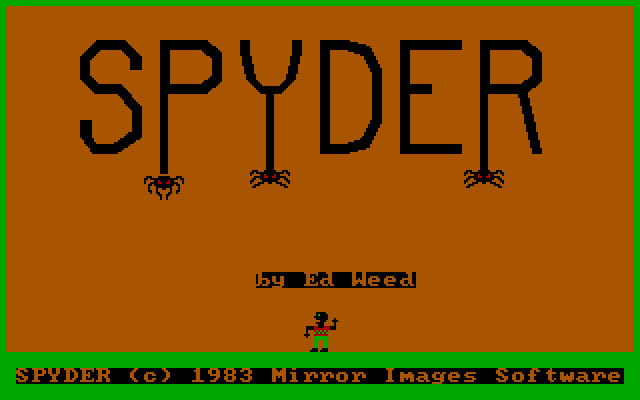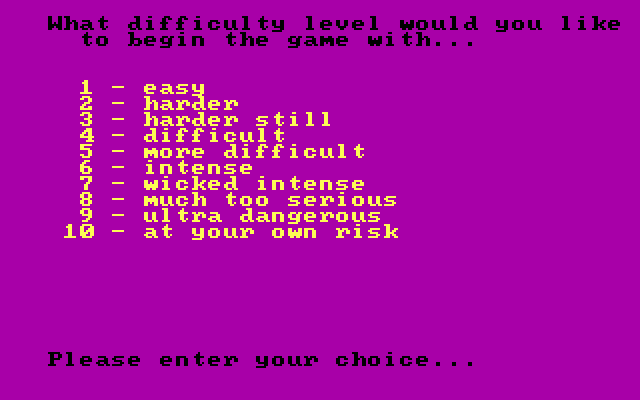Retro Replay Review
Gameplay
Spyder delivers fast-paced arcade action centered on one simple objective: stop the spiders before they reach you. As arachnid hordes descend from the top of the screen, you must track their movement and use your laser to eliminate them. The controls are tight and responsive, allowing you to swiftly pivot your aim from one corner to the other. This precision is vital, since spiders can swarm in large numbers and force you to prioritize which threats to neutralize first.
Resource management adds an extra layer of strategy. You start with a limited ammo supply for your laser, and you’ll need to pick up ammo drops as you go. The sight of your ammo count dipping creates constant tension: do you hold fire and wait for pickups, or do you risk running empty to clear a wave? This mechanic keeps each playthrough fresh, as you adapt your style—sometimes firing in short controlled bursts, other times unleashing rapid streams of laser fire to thin out the biggest clusters.
Another twist comes when a spider reaches the floor. Instead of ending the run immediately, these survivors scuttle horizontally toward your position. At this point, you switch from shooting to stomping them with your foot. This two-stage combat system—shooting above and stomping below—provides a satisfying rhythm and a break from the strictly ranged firefights of many other arcade shooters. Watching a spider squashed underfoot brings an almost cathartic relief.
The difficulty curve ramps up steadily, introducing new spider types with unique movement patterns, speed bursts, or temporary shields. Early stages are forgiving, allowing you to master basic targeting, but by the mid-levels you’ll face relentless streams that test both your reflexes and resource planning. Boss encounters—massive spiders that require multiple shots and timed stomps—offer welcome climaxes between waves, ensuring that you stay engaged throughout.
Graphics
Spyder employs a colorful, cartoon-inspired art style that balances charm with a touch of menace. The spiders themselves are rendered with clean, crisp lines and vibrant hues, making each type easily distinguishable at a glance. Backgrounds feature slowly pulsing laboratory floors, ominous vents, and the faint hum of sci-fi machinery, creating an atmosphere that’s both playful and slightly foreboding.
Animations are fluid and expressive. Each spider has its own gait animation when crawling down and a hilarious “splat” animation when stomped. Your laser beams produce bright flashes and subtle distortion effects on impact, lending weight to each shot. Even the simple act of collecting ammo pickups is enhanced by little particle bursts that add polish and joy to routine gameplay moments.
The UI is straightforward and unobtrusive. A compact ammo meter sits in the top corner with a clear numeric readout, and a wave counter lets you know how far you’ve progressed. Visual indicators for special spiders—such as a glowing outline for shielded variants—ensure you never miss critical information. Overall, the graphical presentation is refined enough to feel modern, yet it retains that nostalgic arcade sheen.
Performance remains rock-solid throughout intense on-screen chaos. There’s virtually no slowdown, even when dozens of spiders, laser beams, and stomped remains are present simultaneously. This consistency ensures your experience remains highly responsive, which is crucial in a game where split-second reactions can make the difference between thriving and getting overrun.
Story
Spyder doesn’t aim for an epic narrative, but it injects just enough lore to give your actions context. You play as a lone security operative in a remote research facility, experimenting on a new breed of arachnid. Predictably, the creatures break free, prompting an all-out containment protocol that places you at the facility’s heart.
The game sprinkles short intermission screens between major waves that showcase snippets of laboratory logs and tongue-in-cheek memos from the facility’s director. These bits of flavor text reveal the spiders’ abilities—some were engineered for stealth, others for rapid reproduction—and hint at a shadowy corporation that may have darker motives for funding the research.
While the story won’t win any awards for depth, it strikes a good balance between humor and sci-fi tension. The premise provides a fun backdrop for the relentless action, giving you someone to cheer for beyond just your high score. If you’re looking for complex character arcs or branching narratives, Spyder won’t satisfy that craving, but its lighthearted plot keeps the stakes clear and the tone lively.
Overall Experience
From start to finish, Spyder delivers a compelling arcade shooter experience. The core loop—shooting spiders, collecting ammo, stomping survivors, and tackling boss waves—is immediately addictive. Its pick-up-and-play nature makes it an ideal choice for quick gaming sessions, yet it also boasts enough depth to keep you coming back for “just one more run.”
Variety in enemy types and wave patterns prevents the action from feeling stale, while the steady progression of difficulty challenges both newcomers and seasoned players. The moment-to-moment thrill of fending off an overwhelming swarm and then vanquishing the last hidden spider underfoot offers a satisfying rush that few shooters can match.
Though brief, the story segments provide a sprinkling of humor and context that elevates Spyder above your average arcade shooter. Combined with polished graphics and rock-solid performance, the game strikes an excellent balance between accessibility and challenge. Whether you’re chasing high scores or simply looking for an engaging diversion, Spyder is well worth your time.
In summary, Spyder’s blend of responsive controls, strategic ammo management, and cheeky sci-fi flair make it a standout title in the modern arcade scene. It may not reinvent the wheel, but it refines classic shooter mechanics with enough personality to leave a lasting impression on players. If you’re in the market for a high-energy, spider-squashing thrill ride, this game is a fantastic pick-up.
 Retro Replay Retro Replay gaming reviews, news, emulation, geek stuff and more!
Retro Replay Retro Replay gaming reviews, news, emulation, geek stuff and more!








Reviews
There are no reviews yet.